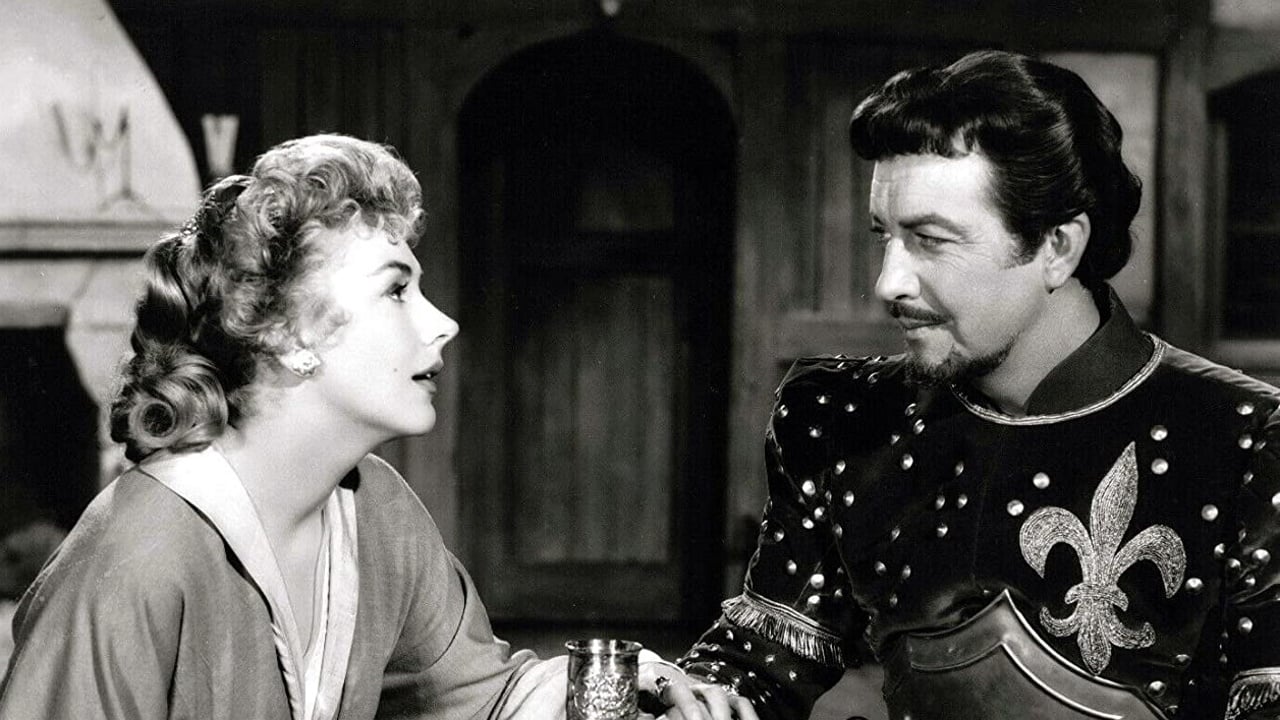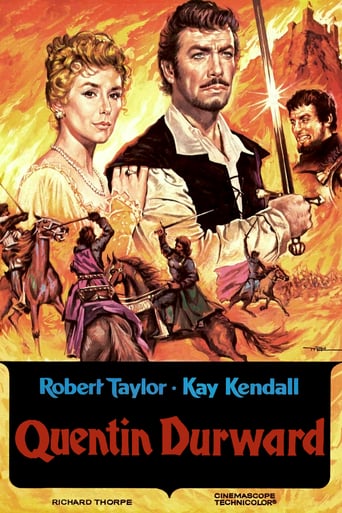



Slow pace in the most part of the movie.
At first rather annoying in its heavy emphasis on reenactments, this movie ultimately proves fascinating, simply because the complicated, highly dramatic tale it tells still almost defies belief.
View MoreAs somebody who had not heard any of this before, it became a curious phenomenon to sit and watch a film and slowly have the realities begin to click into place.
View MoreThis is a must-see and one of the best documentaries - and films - of this year.
View MoreCopyright 1955 by Loew's Inc. An M-G-M picture. U.S. release: 21 October 1955. New York opening at the Mayfair: 23 November 1955. U.K. release: 26 March 1956. Australian release: 11 April 1956. Sydney opening at the St James. 9,011 feet. 100 minutes. SYNOPSIS: Refusing to marry her aged suitor, a duke's ward flees to the king.NOTES: M-G-M embarked on a movie version of Sir Walter Scott's "Ivanhoe" in 1952. This marked the first time any Scott novel had been filmed since way back in 1923. The enormous box-office success of the new "Ivanhoe: prompted M-G-M to follow up with "Quentin Durward". Both these films were directed by super-fast, economy- conscious Richard Thorpe, who also turned his hand to M-G-M's first CinemaScope production, "Knights of the Round Table" (1953). These three movies all share two other features — they were all lensed in England and all starred Robert Taylor.COMMENT: Knighthood is indeed in full flower in this handsomely produced, energetically directed adaptation of Sir Walter Scott's classic novel of a Scottish swordsman's adventures at the French court. Mind you, Robert Taylor is certainly no Scot, but he plays the role with such dash and finesse, it really doesn't matter that his accent is all wrong for the part. And he's helped out by a truly wonderful support cast, including the lovely, high-spirited yet suitably vulnerable Kay Kendall in an ideal role, and Robert Morley perfectly at home as the crafty king. Except for one unfortunate scene (the rape of the monastery), director Richard Thorpe and screenwriter Robert Ardrey keep a nice balance between adventure and comedy. With the exception of this one scene, the film maintains the right flavor of derring-do and then comes to a fine action climax in a blazing bell-tower. The sets and color 'Scope photography are also most attractive.
View MoreThis movie stinks! Although I have always liked Robert Taylor to some degree I do not find him believable in any period piece I have ever seen him in, including "Quo Vadis." He was a very handsome man and he did, at times, command your attention in some roles but I find his vocal inflections simply too American to be real. Taylor did come to stardom through the studio system and I have always thought they should have insisted he work with a dialect coach for these types of roles. Despite a cast that included Robert Morley, this film simply did not hit the mark. In my opinion the best movie I've ever seen him is was "Waterloo Bridge" where he co-stars with Vivien Leigh.
View MoreThis pleasant 1950's Sir Walter Scott Knight's Tale is a nice jaunt down memory lane. Robert Taylor, a poor man's Errol Flynn, contributes a capable performance as the Scottish Knight, Quentin Durward. What Durward lacks in riches, he more than makes up for in the lost values of chivalry, loyalty and humility. His elderly uncle Lord Crawford (Ernest Thesiger) sends him as an emissary to ask for the lovely, wealthy Isabelle, Countess of Marcroy's (Kay Kendall)hand in marriage. In doing so, Quentin Durward falls in love with her and struggles to fulfill his oath of loyalty to his uncle as he attempts to quell his passion for the Countess. In addition to this, add the political intrigue of two ruling cousins King Louis XI (Robert Morley) and Charles, Duke of Burgandy (Alec Clunes). Both have designs on finding her a suitable spouse that will support their own political intrigue. Consequently, this film has the makings of a full fledged adventure complete with sinister characters such as the evil conniving Count William De la Marek (Duncan Lamont) who has his own ideas to further his ambitions.The Technicolor photography is brilliant, and several actual historical castles were used in the film. The action in the film keeps the audience interested throughout. There are several lapses in transition of the filming which I found questionable. On one occasion the bad guys led by Count William De la Marek have a head start on Quentin Durward as they chase the Countess through the woods. Miraculously, Quentin Durward somehow arrives at a bridge and pulls off an ambush well before the fleeing Countess and the pursuing villains. I could never figure out how he pulled that off! Sadly, this is one of Kay Kendall last films. Actor Rex Harrison's beautiful wife passed away in 1959 of leukemia.
View MoreThis is a fascinating and intelligent film that is not only an exemplary model of how the classic Hollywood cinema works, but traditional storytelling in general. Although Robert Taylor's age obscures the point, the story is that classic narrative arc, the growth of a young man into maturity. The film's fascination lies in the tensions inherent in this development. This kind of arc is usually patterned by doubling and opposition, obstacles for the hero to overcome, a black defeated by his white. Such is the ambiguity of this story that Durward's arc is never fully cathartic or resolved. This is an historical epic, so the oppositions are fairly familiar, the most obvious being the tension between public duty and private desire. The impoverished Durward is hired by his aged uncle to investigate the satisfactoriness of a proposed bride for a political union. Hence a private occasion - the reunion of an uncle (with the Oedipal function of father-figure to be superceded by the son) and nephew - is turned into a public one. Both are intimately connected, depend on one another, and create the grid-like pattern of the story, just as these ideals or duties create a grid around the characters' personal feelings. It is significant that this film whose ideological site is the supercivilised realm of the aristocracy, with its codes, rituals, obligations, language - should force its lovers to proclaim their feelings in a 'natural' environment, a meadow-banking forest into which Isabelle has run to hide from the barbaric implications of civilised society.Durward's development is symbolised in a number of ways, for instance through clothing - we first see him in a new outfit bought for him by an uncle embarrassed at his relative's penury; he manages to gain entrance to the King's boudoir by disguise; his appointment to the latter's service involves an elaborate sequence of dressing up in armour. This increase of importance through clothing is appropriate in a society that expresses itself in ritual, and allows the King to complain of the literal discomfort of the Crown as a piece of head gear, as well as the onerous duties it symbolises. However, Durward's increasing status, despite his noble birth, is based on simultaneous humiliation, as he has to beg for the money he subsists on, like a child awaiting pocket money. One would expect his development to involve a rejection of dependence, taking decisions in his own right, but even at the end, having saved the girl and the monarch's neck, his future happiness and status is dependent on the politic whim of two rulers.The great irony of Durward's development is that his progress is one of obsolesence. Repeatedly, his code of chivalry is mocked as irrelevant in a world of Machiavellian power games - further, Isabelle's companion's reminiscences suggest, anticipating Terry Jones in 'Chaucer's Knight', that chivalry was based on the spectacle of barbarity than spurious nobility. Durward's bravery and honesty is usually contrasted with the opportunism and unsporting thuggery of his rivals; and yet, in his use of disguise and deception, in his economy with the truth; in his spiralling of oaths that leave him trapped in a labyrinth of obligation, Durward's so-called chivalry is undermined throughout, and heavily dependent on the quick-witted duplicity of the likes of Hayraddin.'Durward' is gratifyingly intelligent for a Hollywood history film. This is not to suggest that it is very entertaining. Taylor lacks sparkle when his Scotch-with-an-American-accent isn't preposterous; the wonderfully sparky Kay Kendell is wasted in a muted love-interest role; the less said about George Cole's minstral act the better. The fact that Durward and his enemy look the same is probably an attempt at Freudian doubling, with de la Marck the black opposite of Durward's supposed integrity, but the fact that they both look like Vincent Price in one of his less grave moments makes their struggle impossible to take seriously. This kind of thing is so predictable that plot must give precedence to presentation, be it the sprightly choreography of Curtiz's 'Adventures of Robin Hood', or the near-absract pageant of Mann's 'El Cid'. Thorpe never rises above workmanlike adequacy, with little sense of colour or action - his postcard views of chateaux and the like have no resonance because they have no meaning beyond a bland attempt to please the eye. The fight scenes are muddled - although one scene with Durward whipping a leathered man carrying a red-tipped iron while Isabelle looks on clutching a ladder has an overwhelming omni-sexual charge. Robert Morley, however, is terrific as King Louis XI, a sadistic Machiavellian monster with thoroughly amiable manners.
View More